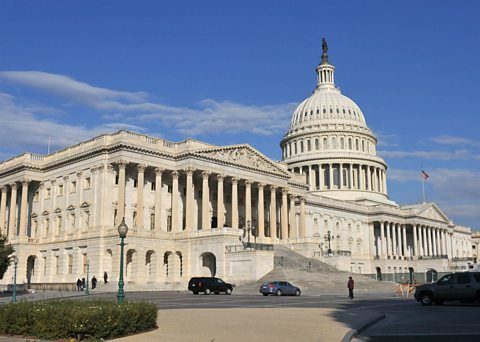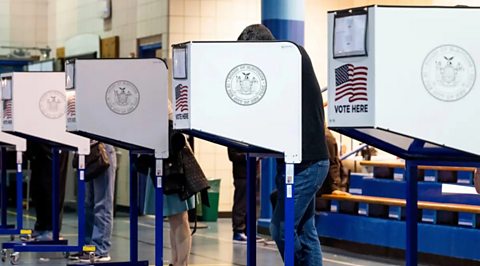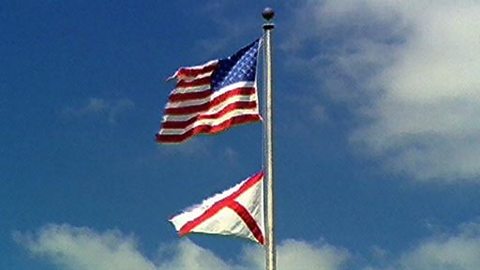How is the US Government structured?
Quick version
In the USA power is shared between the Federal Government and each of the 50 state governments.
- The Federal Government has three branches:
- Executive - the President and Cabinet
- Legislative - US Congress
- Judicial - US Supreme Court and federal courts
Federal Government has the right to make decisions on areas including:
- the military
- federal taxes
- printing money
- regulations on trade between states
State governments have their own laws on many areas:
- crime and punishment
- gun control
- ages for marriage, driving and education
Video
Watch this video explaining the US Constitution and different branches of US government.
What is the US Constitution?
When the founding fathers of the USA began writing the basic laws about how the country will be governed, known as the Constitution, they had a number of different considerations to weigh up.
They wanted to create a fair and strong national government that could also protect the rights and interests of the citizens.
They decided to separate government into state government, local government and federal government.
State and local government is responsible for things like police departments, fire departments and schools.
Each state has its own written constitution, and all state governments are modelled after the federal government.
Federal government looks after things like immigration, foreign affairs and minting money.Some powers, such as taxation, law making and law enforcement are shared between state and federal governments.
This division of power is called federalism.
Federal government is divided so that no one part of government holds too much control.
This is known as the separation of powers.
The Constitution separates the power of government into three distinct branches.
The legislative branch makes the laws.
It is run by US Congress and it's made up of the Senate and the House of Representatives.
The Executive Branch is responsible for enforcing the laws that Congress passes.
It is the government led by the President who is supported by the Vice President and Cabinet and theJudicial Branch enforces and interprets the law and is made up of the Supreme Court, the highest court in the country, and all federal courts that deal with national rather than state laws.
Each branch of government holds a lot of power, but it's important that no one branch becomes too powerful.
The separation of powers was the founding fathers system of checks and balances, a way for each branch to limit or check the other's power.
The executive branch has the power to block legislation passed by Congress, which is called a veto, and the judicial branch can also check the legislative branch by declaring laws not in line with theConstitution, or unconstitutional.
The legislative branch can check the executive branch by overriding the presidential veto.
It can also formally charge the president of a serious offence whilst in office. This is known as impeachment.
And the judicial branch can also check the executive branch by declaring presidential actions unconstitutional.
The executive branch can check the judicial branch by nominating judges,but the legislative branch needs to approve the nominated judges and can also check the judicial branch by impeaching judges.
The point here is that each of the branches has the power to limit or check the other two, creating a balance between the three separate powers.
Learn in more depth
How is power shared in the USA?
Power in the USA is not concentrated on any one person or governing body.
As written in the US Constitution, power is shared between:
- the National Government (often referred to as the Federal Government)
- each of the 50 US state governments
Federal Government has specific powers, as laid out in the constitution. State governments have powers over everything else. There are a number of areas over which both Federal and state governments share power.
Federal Government
The US Federal Government's powers are clearly stated in the US Constitution.
For example, the Federal Government has the right to make decisions on the following:
- the military
- all federal taxes
- printing money
- regulations on trade between states
Anything that is not stated in the US Constitution as a federal power is a state power.
State government
The United States of America is a union of 50 states.
Each state has its own legal standing and authority, independent of the Federal Government.
This means that each state has the right to make decisions in those areas not decided by the US Federal Government.
For example, each state can have its own laws on the following:
- crime and punishment (including the death penalty)
- gun control
- ages for marriage, driving and education
- levels and types of state taxes
How is the US Federal Government structured?
The Federal Government is divided into three branches, each with its own powers:
- the Executive Branch - led by the President
- the Legislative Branch - US Congress
- the Judicial Branch - US Supreme Court
What is the Executive Branch of US Government?
The Executive Branch is led by the President, who is also head of state and Commander-in-Chief of the armed forces.
The President's role is to implement and enforce laws passed by Congress.
To do this, the President is assisted by the Vice President, the Cabinet and heads of federal agencies.(Federal agencies perform similar roles to the civil service in Scotland or the UK.)
What is the Legislative Branch of US Federal Government?
The Legislative Branch refers to the US Congress.
Congress has a number of responsibities:
- making and amending laws
- declaring war
- voting on Presidential appointments (people nominated by the President to take on certain jobs, such as heads of federal agencies or judges on the Supreme Court)
- investigating the work of government or federal departments
Congress has two parts:
- House of Representatives
- Senate
What is the Judicial Branch of US Government?
The Judicial Branch is the Federal Court system.
The highest court in the US is the Supreme Court:
- the role of a Supreme Court is set out in the Constitution
- currently there are nine Supreme Court Justices
- they make decisions on the rule of law
Other federal courts have been established by Congress:
- United State district courts try most federal cases
- Courts of appeal review any decisions from district courts that have been appealed against
Supreme Court Justices and Federal Judges are nominated by the President and approved by Congress. They serve until retirement or death. In theory, Congress can impeach and remove a Justice or Federal Judge from office, but this has only happened once.
How is separation of powers organised?
The separation of powers is the term used to describe the division or sharing of powers between the Executive (President), Legislature (Congress) and Judiciary (Supreme Court).
The framers (writers) of the American Constitution in 1789 went to great lengths to ensure that political power would not be concentrated within a single branch of the national government.
Therefore, there is a system of checks and balances in place. This allows each branch of government to hold a level of control over the others.
For example:
- the President nominates ambassadors and members of the US Cabinet, selects federal judges and negotiates international treaties, but all are subject to approval by the Senate
- the Constitution specifies that only Congress has the power to declare war, but the President is Commander-in-Chief of the Armed Forces
- the President can suggest new laws but it is Congress which the makes law
- the President can veto bills (new laws passed by Congress) but Congress, under certain conditions, can overturn a presidential veto
How are US citizens represented in Federal Government?
Americans are represented in politics by many different representatives.

The US Federal Government is based in Washington DC.
The Executive Branch is led by the President:
- Presidential elections are held every four years
- Voters cast their vote for President directly
- The decision on who becomes President is made indirectly through the Electoral College system
Members of the Cabinet and heads of Federal Agencies are nominated by the President and passed by Congress. They do not have to be elected officials.
Members of the Legislative Brach are elected by voters:
House of Representatives
- there are 435 elected members representing the 50 states
- the number of members for each state is in proportion to the state's population
- members are elected every two years
Senate
- there are 100 senators
- two senators represent each state
- each senator serves a six-year terms
- terms are staggered with approximately one-third of the seats in senate up for election every two years
- the Vice President acts as President of the Senate and holds the decisive vote when votes on any bill are tied

How are US citizens represented in state government?
Like the Federal Government, state governments have three branches:
- Executive Branch led by a directly elected Governor
- Legislative Branch made up of elected members
- Judicial Branch made up of State Supreme Court and other courts
States are divided into separate counties (sometimes known as boroughs or parishes) and municipalities. Usually the mayors and councils who lead local government are directly elected.
Test what you have learned
Recap what you have learned
- The US Constitution outlines the structure of the US Government.
In the USA power is shared between the Federal Government and each of the 50 state governments.
Federal Government is based in Washington D.C. It has the right to make decisions on areas including:
- the military
- federal taxes
- printing money
- regulations on trade between states
State governments have their own laws on many areas:
- crime and punishment
- gun control
- ages for marriage, driving and education
The Federal Government has three branches:
- Executive Branch- the President, Vice President, Cabinet and federal agencies
- implements and enforces laws passed by Congress
- head of state
- Commander-in-Chief of armed forces
- Legislative Branch
- the US Congress, made up of the House of Representatives and Senate
- makes and amends laws
- declares war
- votes on Presidential appointments
- Judicial Branch
- the Supreme Court and federal courts
- make decisions on the rule of law
- try federal cases
Separation of powers is the division of powers between the Executive, Legislature and Judiciary. It aims to ensure political power is not concentrated within a single branch of the national government.
US citizens are represented by a number of elected officials:
- the US President and Vice President
- 435 members of the House of Representatives (representing the population of each state in proportion)
- 100 senators (two from each state)
More on World power: USA
Find out more by working through a topic
- count3 of 5

- count5 of 5
